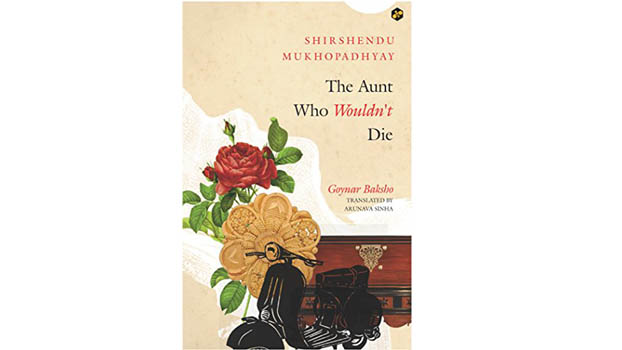Book Talk
The Aunt Who Wouldn’t Die
by Shirshendu Mukhopadhyay

18-year-old Somlata comes from a poor family so thinks that she’s made a good match when she marries 32-year-old Chakor Mitra Chowdhury, the second son of a once noble Bengali family who lives all together in a big, if somewhat tatty, house. Chakor is educated, handsome and kind but neither he nor any of the other men in the family have ever had a job in their lives and Somlata quickly realises what a problem that is when she discovers that the family has taken to selling off land and jewellery in order to keep themselves afloat.
The Mitras are dominated by Pishima, Somlata’s aunt-in-law, who was widowed at the age of 12 and whose jewellery box is coveted by the rest of the family as being a way of keeping them going for longer. Pishima thinks the family made a mistake in allowing Chakor to marry poor Somlata and Somlata fears the woman’s sharp tongued jibes.
But then one day Somlata discovers Pishima’s body in her room. Pishima may be dead, but her ghost still lingers and it orders Somlata to take her jewellery box and hide it from the rest of the family so that they can’t sell the contents. Thereafter, the malicious and spiteful ghost refuses to leave Somlata alone – criticising her, telling her secrets she’d much rather not know and trying to tempt her into wickedness. And all the time the Mitras’ money continues to run out.
Somehow, Somlata must try to chivvy the family into taking control of its destiny without threatening the precarious relationships within it and while batting off the increasingly domineering Pishima.
Shirshendu Mukhopadhyay’s literary horror novel (published in India in 1993 but translated into English from Bengali for the first time by Arunava Sinha) is a domestic drama pitting the genuinely malevolent Pishima against the virtuous, obedient Somlata and I liked the alternating sections following her daughter, Boshon, a restless teenager who has forsaken love but the open ending is very frustrating and may alienate some readers.
Mukhopadhyay neatly sets out the dynamics at play in the Mitra family and Somlata is a sympathetic protagonist, a stranger to their world who comes from poverty and is therefore more respectful of their background and position in society. Although her virtuous respect for her husband and family is a little overdone for my tastes I liked the way she carefully works to persuade her husband and in turn brother and father in law to her way of thinking. Also good is the conflict between her and her sister-in-law Bandana, who is aware that Somlata has Pishima’s jewellery box and wants her cut. Pishima herself is a malevolent spirit, constantly seeking to manipulate and bully Somlata into doing as she wishes but there’s also something tragic about her and the longing she has for love and her feeling that she was cheated out of it by being widowed at such a young age.
The alternative sections with Boshon are a neat contrast and I liked her more restless nature and the way she had decided not to pursue love for reasons that become apparent as the novel progresses. Mukhopadhyay also does a good job of capturing the frustrations and rivalries of friendship between teenage girls, particularly Boshon’s frustration at Nitish’s constant yammering about the boy she loves.
Where the book fell down for me was in the ending, which is ridiculously open-ended and, for me, frustrating given the preceding events. I’m not familiar with Indian literature so don’t know if this is usual or not, but I did find it a real shame given that the rest of the book is a neat mix of domestic drama and supernatural menace and I think that Sinha does a really good job with the translation, which gives the language a lyrical flow. None of this would prevent me from reading a translation of Mukhopadhyay’s other work though and I hope to see more of it.



